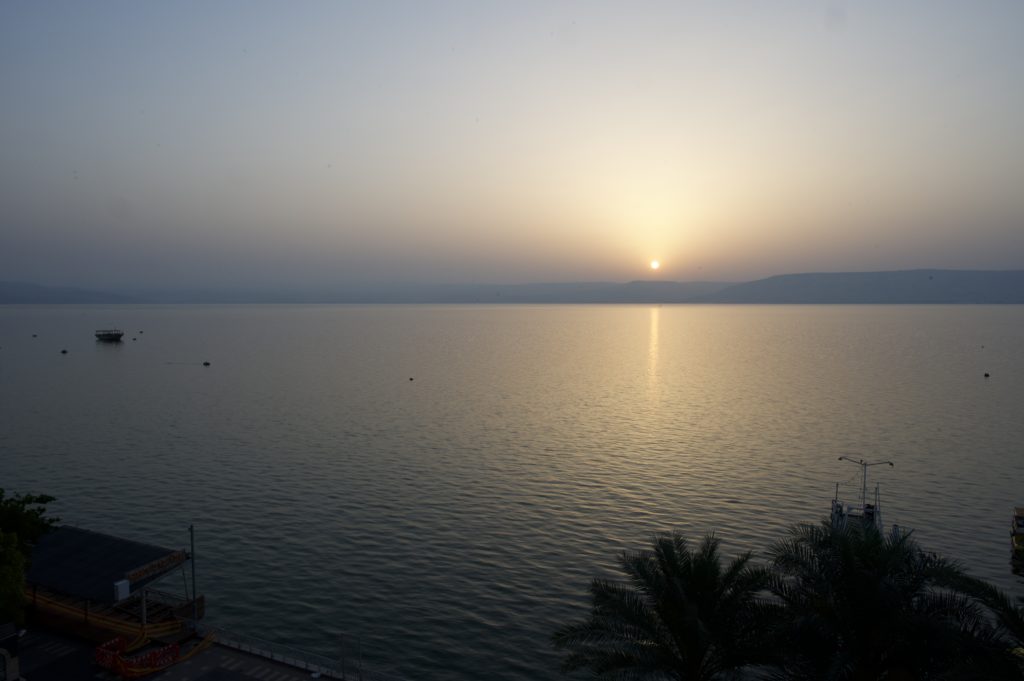
This day was packed, and it was awesome! I woke up just after 3:30am and couldn’t go back to sleep, so I eventually just decided to get up and watch the sunrise over the Sea of Galilee. I setup my tripod on the balcony to take some long exposure shots of the sunrise while drinking an excellent cup of coffee.
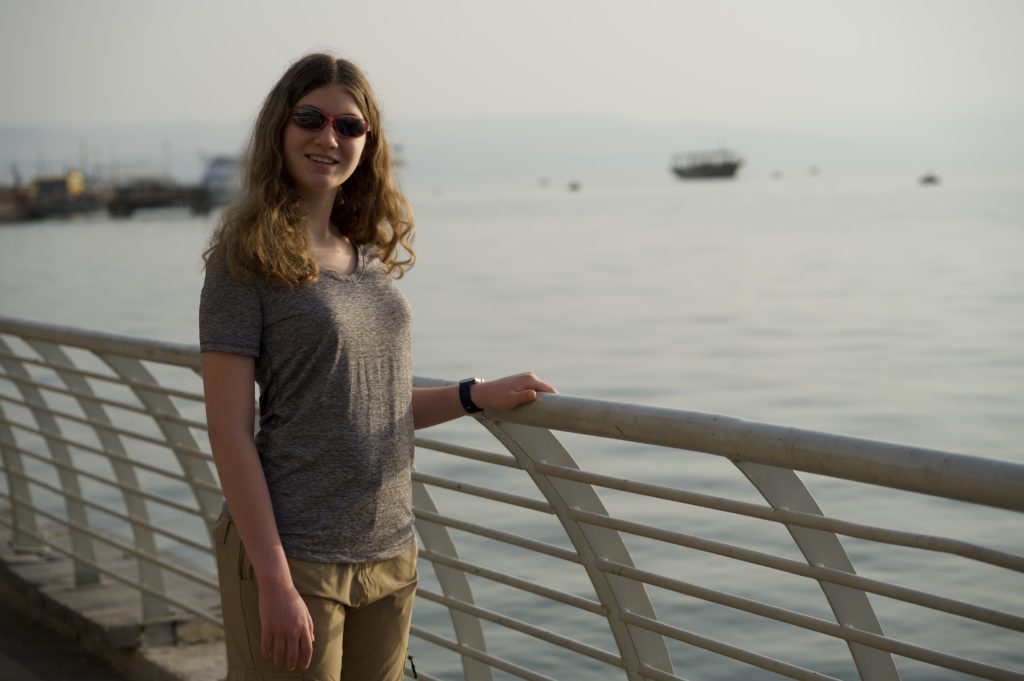
Once Sara woke up, we quickly got ready and walked down to the promenade on the Sea of Galilee (Olivia and Kate are in one room on the 10th floor, and Sara and I are in a different room on the 5th floor). We took some pictures, saw several feral cats, and ran into Janna and Daniel Palk from our group.
At 7am, we met Olivia and Kate for breakfast in the main dining room. I ended up having three cups of coffee this morning, and all were excellent. One was straight black, one was a cafe latte, and the other was a cappuccino. We all tried several different cheeses, which is a staple of breakfast in Israel.

After breakfast, we boarded the bus at 8am and began our journey to Zippori, which was our first destination. Along the way, we had some great views of upper Galilee from the right side of the bus. It is not quite as green as I saw it in January 2020 since they are in the dry season, but there is still a lot of green vegetation and green patches of land due to the massive irrigation in the area. Much of this irrigation comes from the Sea of Galilee.
When I was here two years ago, the Sea was really down due to lack of rain and irrigation, but Ami said that due to the higher-than-normal rainfall over the past year, the Sea of Galilee is back up to target levels. I was able to see this difference throughout the day.
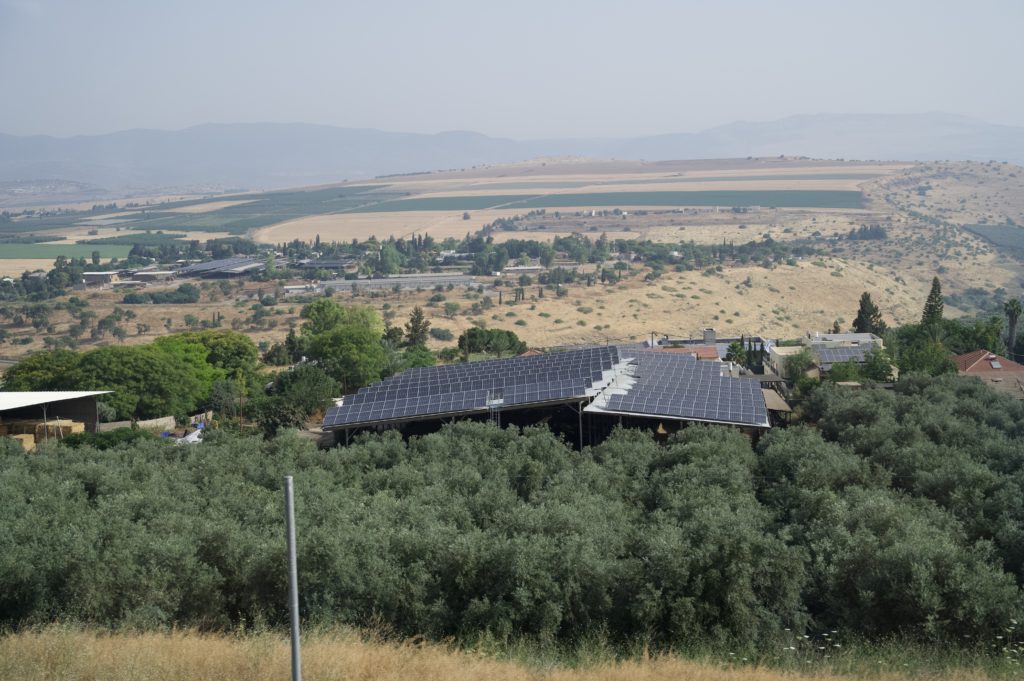
Ami also pointed out all of the solar panels on buildings along the way. As with any other part of the world, producing energy is always a concern. They don’t have any oil in the country, but they do have LOTS of sunlight, so they make use of it to generate power.
Zippori (Sephoris)
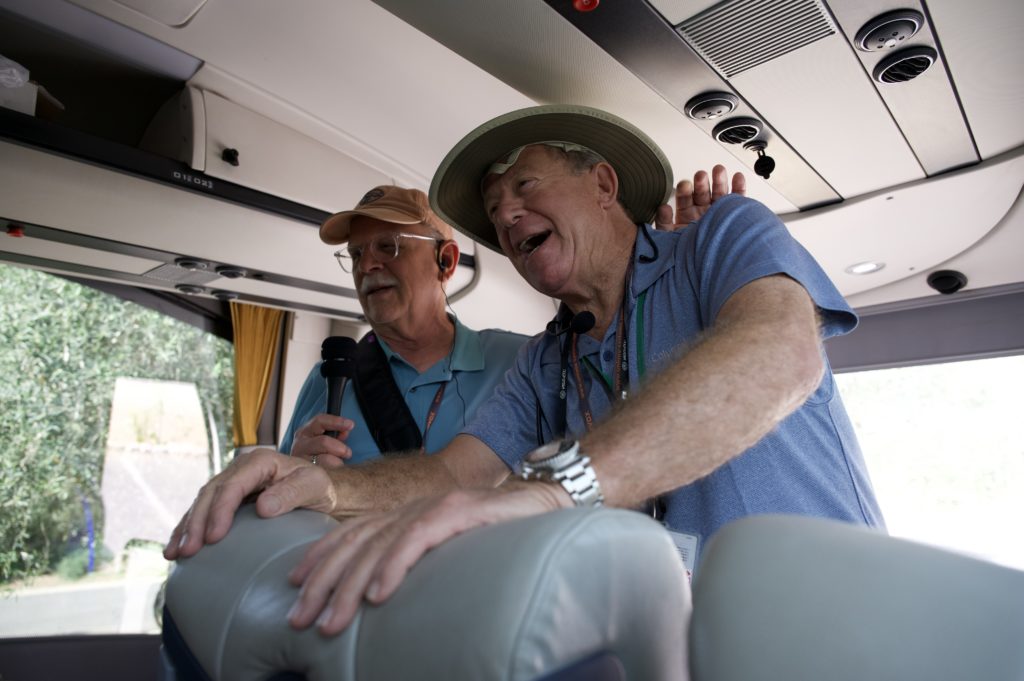
When we first arrived at Zippori, Bruce presented Ami with a new Tilly hat from members of the group before we got off the bus. He had lost his previous Tilly hat and was very appreciative to receive a new one. Next, we started off with a short film about the history of this city.
Zippori was a major city in lower Galilee, and it is four miles northwest of Nazareth. During the time of Jesus, it was a mixed city of the Romans and the Jews. It is never mentioned in the Bible, but it is possible that Jesus might have come here due to its proximity to His hometown of Nazareth.
The name of the city is derived from a word meaning bird because it is on a hill (i.e. bird’s eye view). From the top of the hill, one has a 360-degree view of Galilee. During the crusades, its name was changed to Sephoris.
Zippori is very important in Jewish history as the Sanhedrin moved to Zippori in the 2nd or 3rd century AD. The Mishnah (oral tradition) was completed in Zippori during the 3rd century AD and is the basis of the Talmud and all Jewish law today.

Our first stop in Zippori was a 5th century AD synagogue. The hallmark of this synagogue is the incredibly intact mosaic floor. This floor was discovered in 1993 by someone doing work with a tractor.

The floor includes elements from temple worship in Jerusalem such as the menorah and shofar, a depiction of Abraham sacrificing Isaac, and a zodiac featuring Helios god of the sun.
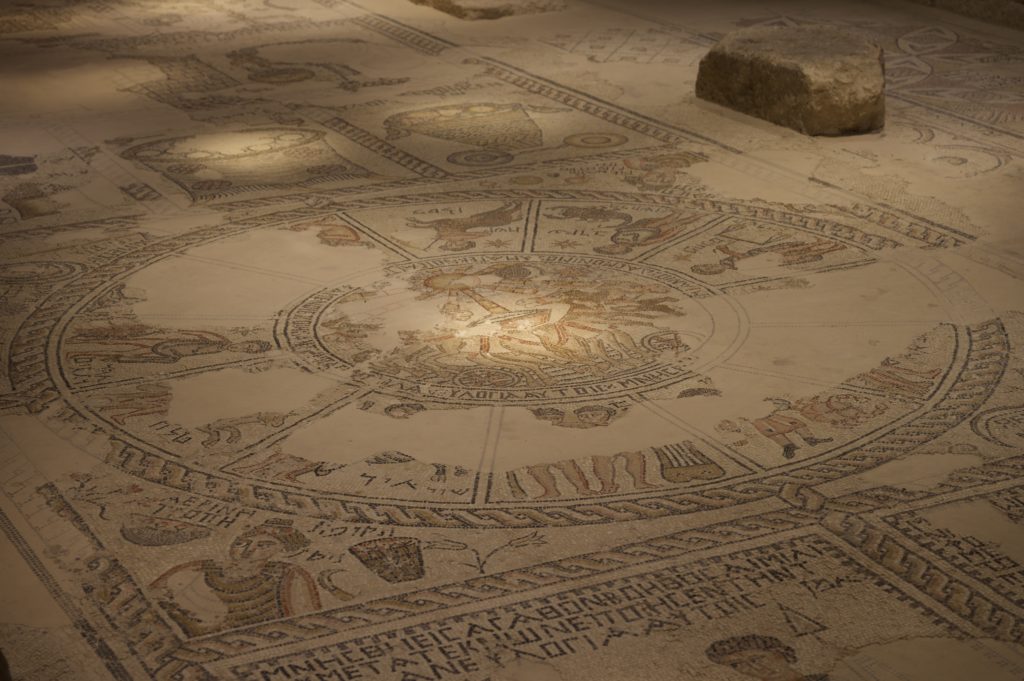
This shows the influence of the Greeks and Romans on Jewish worship. This can also be seen in the fact that inscriptions within the mosaic are written in Greek, Hebrew, and Aramaic.
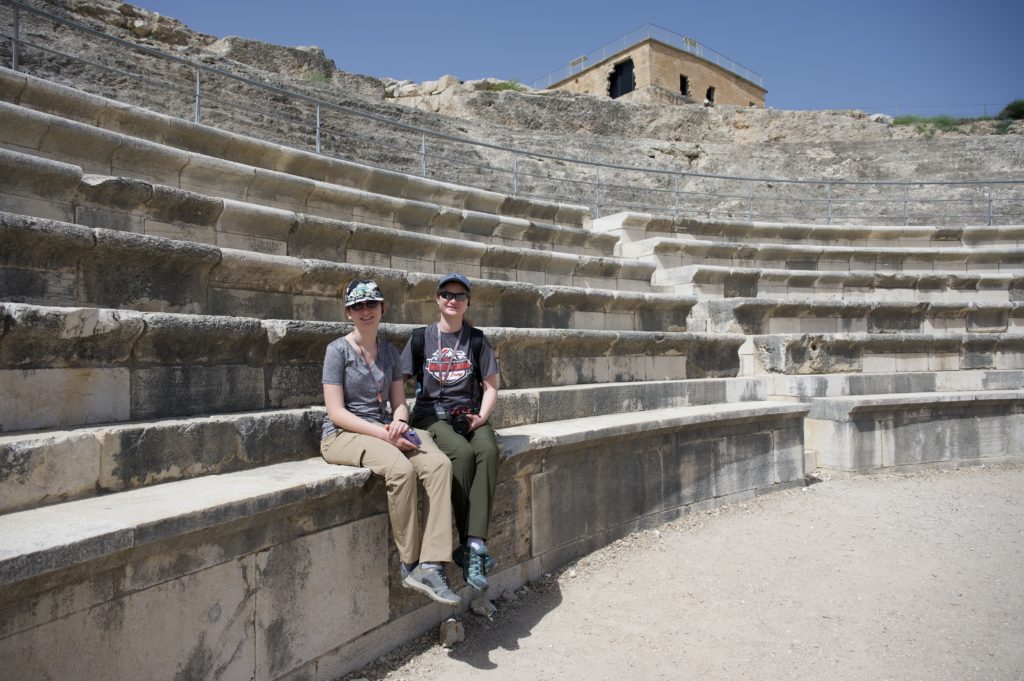
Next was a small Greek style theater from the 2nd century AD. Ami pointed out that theaters were always built facing the best views, and this is no exception as it overlooks Galilee. Ami also pointed out that it was a theater and not an amphitheater as the latter would be a full circle. Theaters were used for entertainment and amphitheaters for sport.

As we continued walking up the hill, we came to the Jewish quarter which is filled with lots of Mikvah or ritual baths. These baths were very important in Jewish life as every Jew was to wash at least once per week in fresh, clear water before the sabbath. There were also many different ritual washings that were required by Judaism.
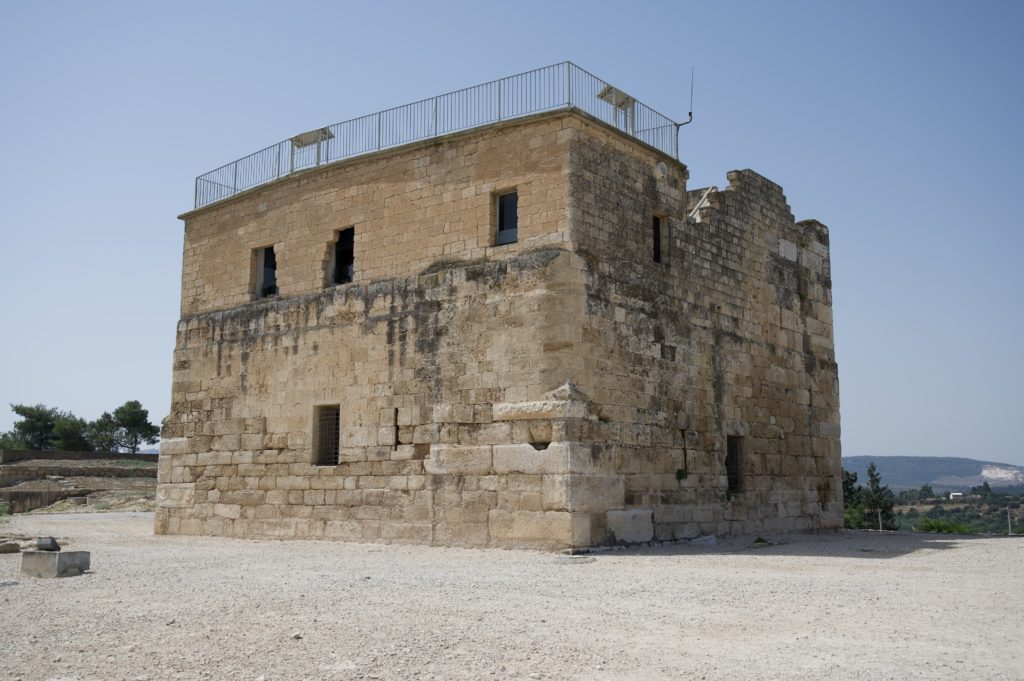
On top of the hill is a Citadel (fortress) from the period of the Crusades in the 11th to 12th century AD. Ami pointed out something that I had not noticed before. Some of the “stones” used to build the citadel were actually coffins.

You can clearly see one at the bottom corner of one of the sides. From the top of the hill, you definitely have a 360-degree view of Galilee, and you also have a view of the nearby Arab village of Nazareth.
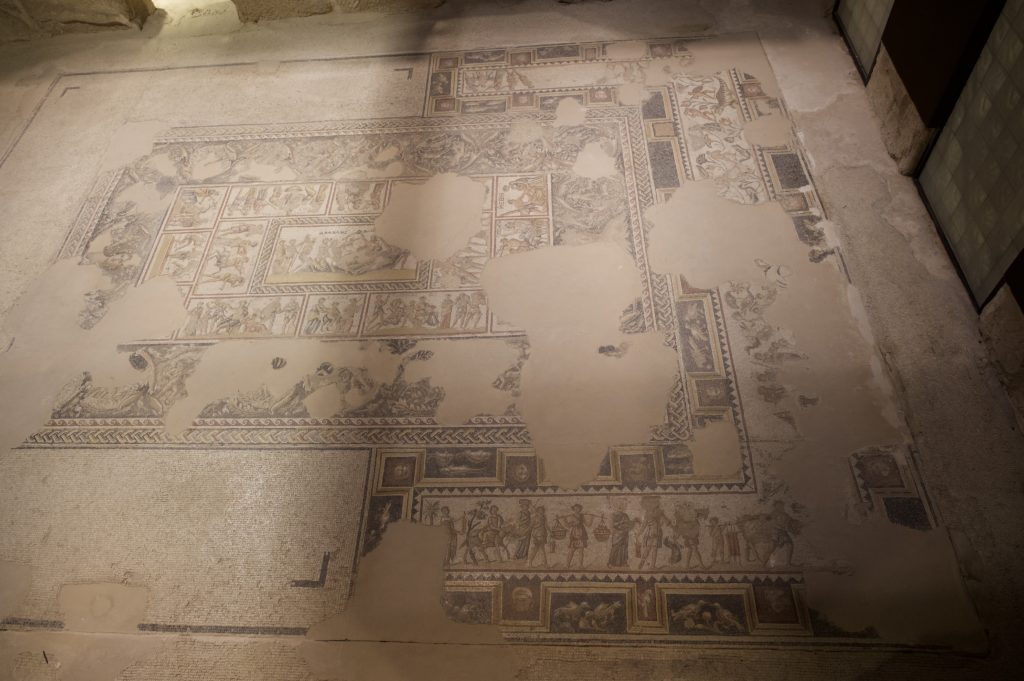
Just below the Citadel are the remains of a private house from the 2nd century that is called the Dionysus House. Dionysus was the Greek god of wine. This name comes from a beautiful mosaic floor that depicts Dionysus.
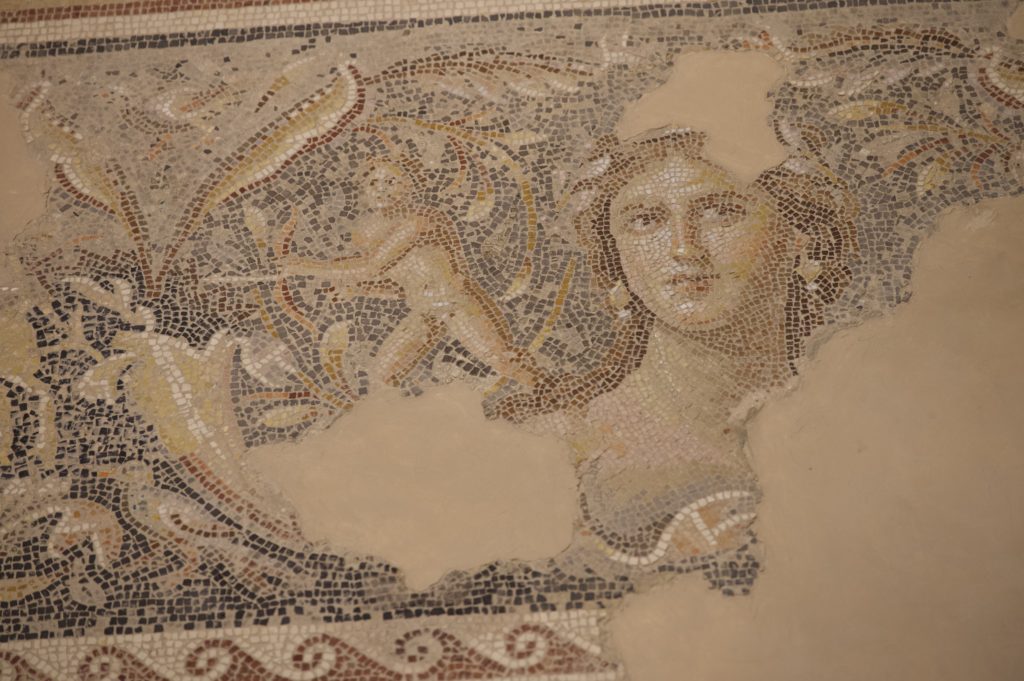
The mosaic also contains a beautiful, detailed depiction of a woman’s face that is known as the “Mona Lisa of Galilee.” This would have been the house of a wealthy family and would have had room for 3 beds. It was destroyed by an earthquake in the 4th century AD.

Back down the hill, there is a public building known as the House of the Nile River from the 5th century AD (Byzantine Period). This building has a very detailed mosaic floor that contained scenes from the Nile River. The back side of the house also has mosaics depicting Amazon women from Greek mythology, a centaur, and a Roman soldier.

In the middle of all this, there is a large crack that is clearly visible from an 8th century AD earthquake. While touring this building, Ami taught us a little about how mosaics were made. The most fascinating part of this to me is that the stones are not painted. Different color stones are found to make the different designs.

The final thing we saw were Roman roads from the 2nd century AD. Ami pointed out that the Romans placed the stones diagonally to improve grip while walking on them. We were able to see games that had been carved in the road, and large ruts from chariots.

At the end of the visit, I asked Olivia, Kate and Sara what their favorite things in Zippori were. Sara said the theater. Olivia, Kate, and I all said the mosaic floor from the synagogue.
Mt Arbel
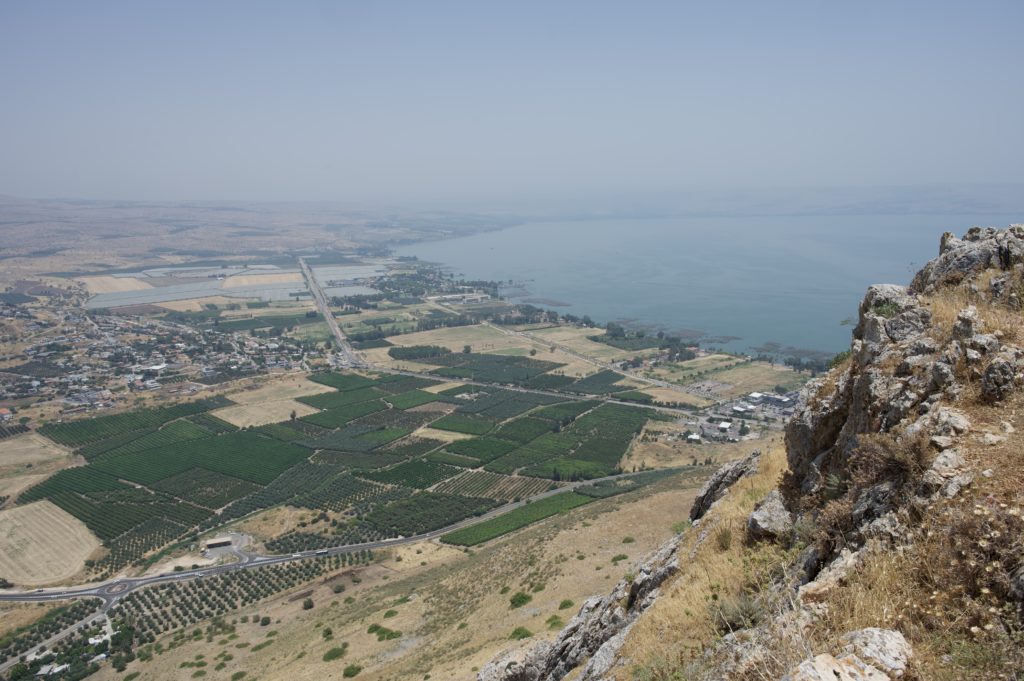
Back on the bus we rode back across northern Galilee to Mt. Arbel, which is a place I had never been before. This not a biblical site (some claim it as the location of the great commission) but provides a great view of the northern end of the Sea of Galilee, which is the heart of Jesus’ Galilean ministry. While today was very hot and hazy, it was still an awesome view.
Sea of Galilee
After Arbel, we drove back down to the shore for a boat ride on the Sea of Galilee. Even though it is known as a “Sea,” it is really a small lake with a surface area of 64 square miles. The lake is 13 miles from north to south and 7 miles from east to west.
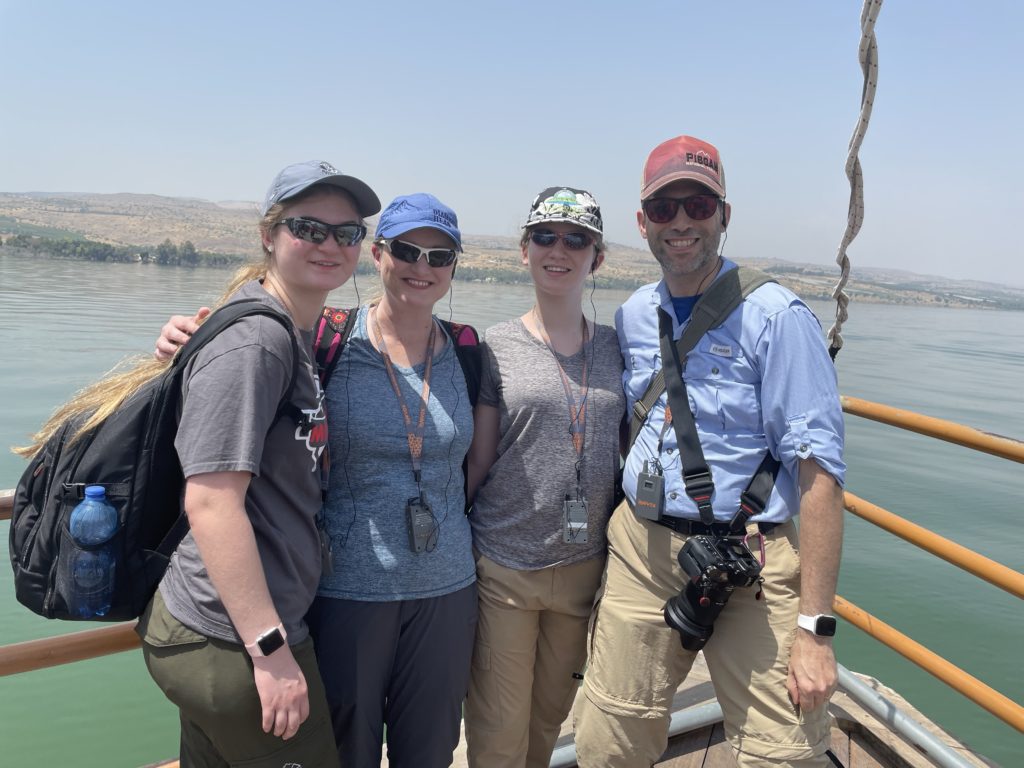
On my last trip, there were many obvious signs that the level of the lake was down due to over irrigation and drought. This time, it looked a lot different near the shore because the last year had produced a lot of rainfall as mentioned above. One example is that two years ago the shore was covered with marsh. Today it was deep enough that kids were swimming near the bank.

This additional rain is needed, because the Sea of Galilee provides 40% of the fresh water to the surrounding area. The Jordan River feeds into the Sea of Galilee from the north and flows out from the south. The sea takes water from the Jordan and then gives it to the Dead Sea.
The Sea of Galilee is also a very important location in scripture and is known by the following names:
*Sea of Chinnereth (Numbers 34:11; Joshua 12:3; 13:27)
*Sea of Gennesaret (Luke 5:1)
*Sea of Tiberias (John 6:1; 21:1)
*Sea of Galilee (Matthew 4:18)
The Gospels refer to the Sea of Galilee 53 times (48 times as “sea” or “Sea of Galilee”; five times as “lake”). Two significant events from Jesus’ life occurred directly on the Sea of Galilee:
*Jesus calming the storm on the Sea of Galilee (Matt 8:24–26; Mark 4:35).
*Jesus walking on the Sea of Galilee (Matt 14:22-33; Mark 6:45–53; John 6:16-21)

Just like last time, this boat ride is surreal. While there are many places in Israel that are “traditional,” and we don’t know whether the actual even happened there, this is definitely not the case with the Sea of Galilee. This IS the place where Jesus walked on the water, and the place where he calmed the storm. It is amazing to be floating on the same body of water. Sara said that this was her favorite thing we did today.
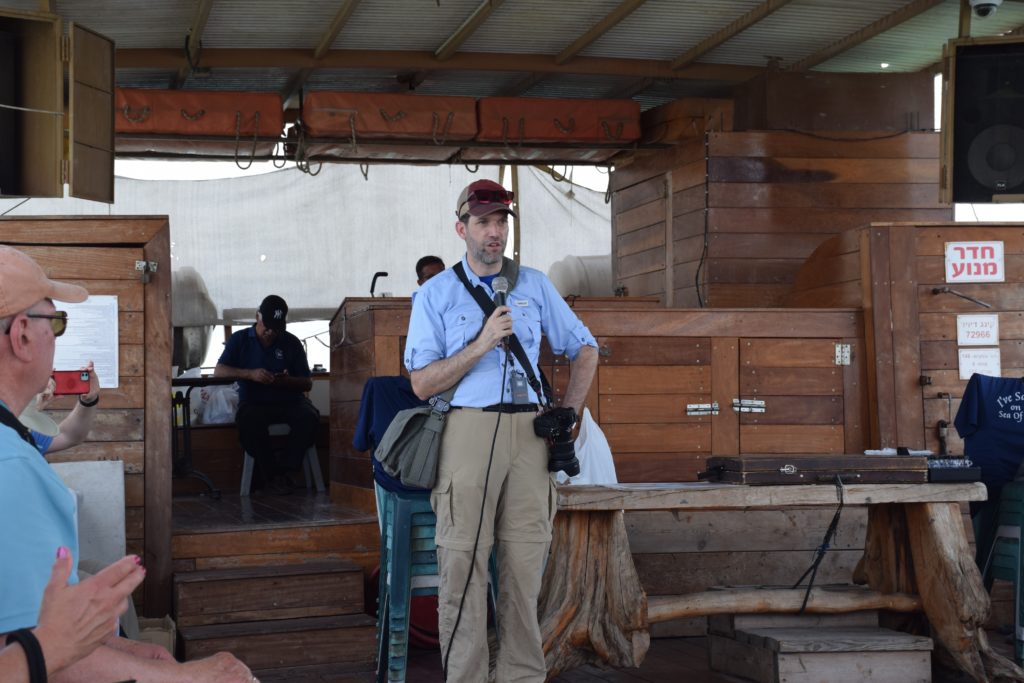
While on the boat, Bill, Mike, and Lee read scripture from the accounts of the miraculous catch of fish (Luke 5:1-11), Jesus calming the storm (Mark 4:35-41), and Jesus walking on the water (John 6:16-21). I said a few words about Jesus’ Galilean ministry and that there is no doubt this is the location where Jesus performed the mighty works mentioned above. Derek then led us in “Master the Tempest is Raging” before we headed back to the dock.
Ancient Galilee Boat
Right next to the dock is a building housing an ancient boat that was discovered at the Sea of Galilee in 1986. We watched a movie about the boat and the preservation process. The boat is dated to the first century AD and was discovered during drought time by two men who found ancient nails sticking up through the mud.
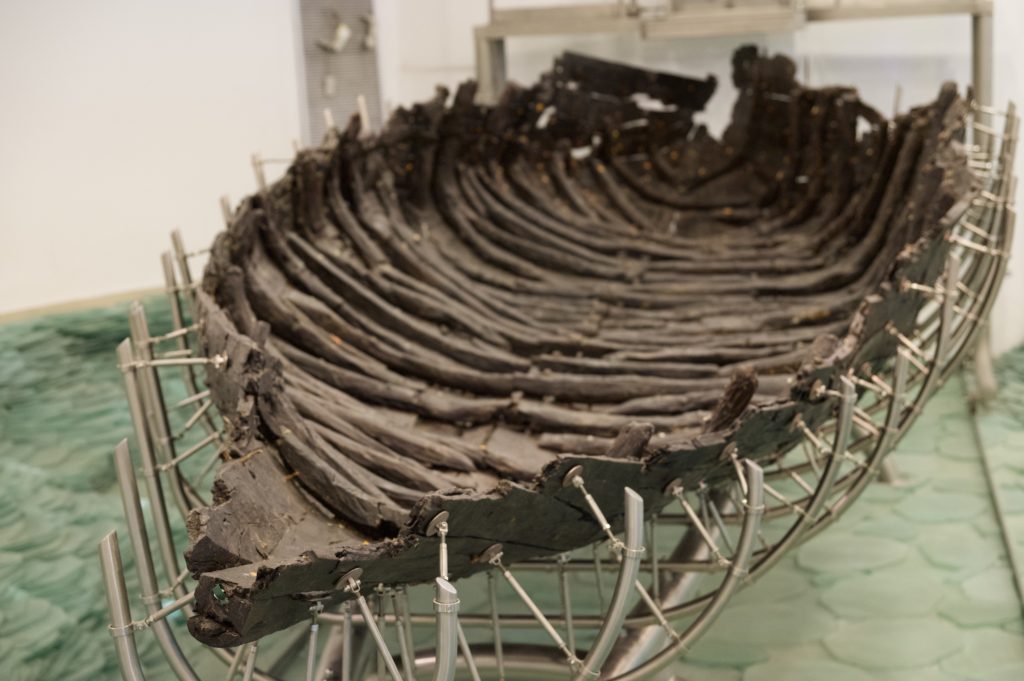
The extraction was completed by covering the entire boat in polyurethane foam and sailing it on the sea so that it could be extracted by a crane. The preservation process was extensive and took 10 years before it was ready to display.
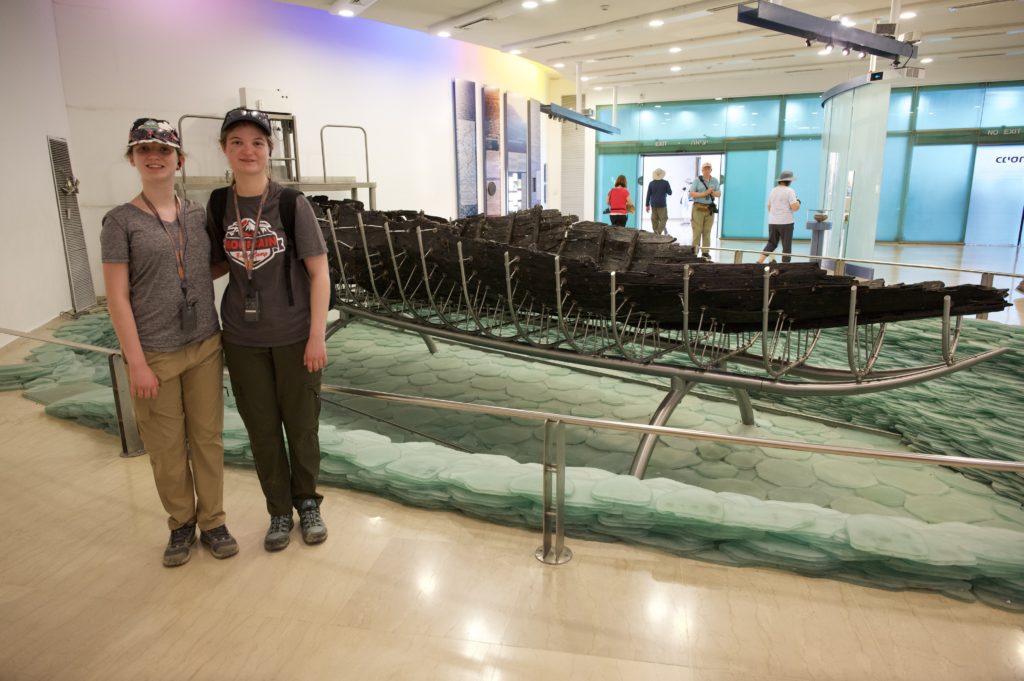
This boat is incredibly intact. While we have no idea whose boat it was, it is amazing to see what a fishing boat from the time of Jesus looked like.

By the time we left the ancient Galilee Boat, it was after 3pm, and we finally were able to get some lunch. We stopped by a place near Magdala and two of us had shawarma and two had falafel. My shawarma was delicious.
Capernaum

We drove to Capernaum on the northwest shore of the Sea of Galilee. This city was inhabited continuously from the 2nd century BC to the 11th century AD, when it was abandoned sometime before the Crusader conquest. According to Ami, the name Capernaum literally means City of Nahum, though we don’t know which Nahum this is referencing.
This again is a very important location in scripture, especially in the ministry of Jesus. It was the home base of Jesus during His Galilean ministry, after he left Nazareth (Matthew 4:12-17) and was referred to as Jesus’ “own city” in Matthew 9:1. The Gospels reference Capernaum 16 times, but it is not mentioned in the rest of the New Testament.
The Gospels also speak of Jesus’ mother and brothers having been in Capernaum (John 2:12), and Matthew 17:24–27 demonstrates that Jesus paid the temple-tax there for Himself and Peter.
Capernaum is well known for being the town in which Peter lived and where Jesus healed Peter’s mother-in-law (Matthew 8:14–15, Mark 1:29–31, and Luke 4:38–41). The calling of Matthew is also featured prominently in relation to Capernaum. The town housed Matthew and other tax collectors (Matt 9:9–10).
Jesus cursed Capernaum, along with Chorazin and Bethsaida, because even after He performed miracles there, the inhabitants of these towns did not believe He was the son of God (Matthew 11:21; Luke 10:13).
Jesus performed the following miracles in Capernaum:
*Healed Jairus’ Daughter (Matthew 9:18–26; Mark 5:21–43; Luke 8:41–56)
*Caught a miraculous number of fish (John 21:4–14)
*Healed a demon possessed man (Mark 1:21–28)
*Healed Peter’s mother-in-law (Matthew 8:14–15)
*Healed a paralytic (Matthew 9:2–8; Mark 2:1–12; Luke 5:17–20)
*Healed the centurion’s servant (Matthew 8:5–13; Luke 7:1–10)
*Healed the woman with the issue of blood (Mark 5:21–43)
My favorite event that took place in Capernaum is the “bread of life” discourse from John 6 that comes after Jesus fed the 5000 and walked on the water in teh same chapter.
Ami led us around the site. We first explored the excavations of the city from the time of Jesus. According to Ami, this was likely a small town filled with simple people based on the size of the dwellings.

In Capernaum is a synagogue from the 4th century AD that was built on top the synagogue from the 1st century AD (John 6:59).

Ami showed us a number of artifacts and carvings that have been recovered from the 1st century synagogue before we proceeded into the 4th century synagogue.

While in there, Ami allowed me to speak to the group about the events of John 6, and then to read from the “bread of life” discourse, culminating in John 6:59:
(ESV) “Jesus said these things in the synagogue, as he taught at Capernaum.”
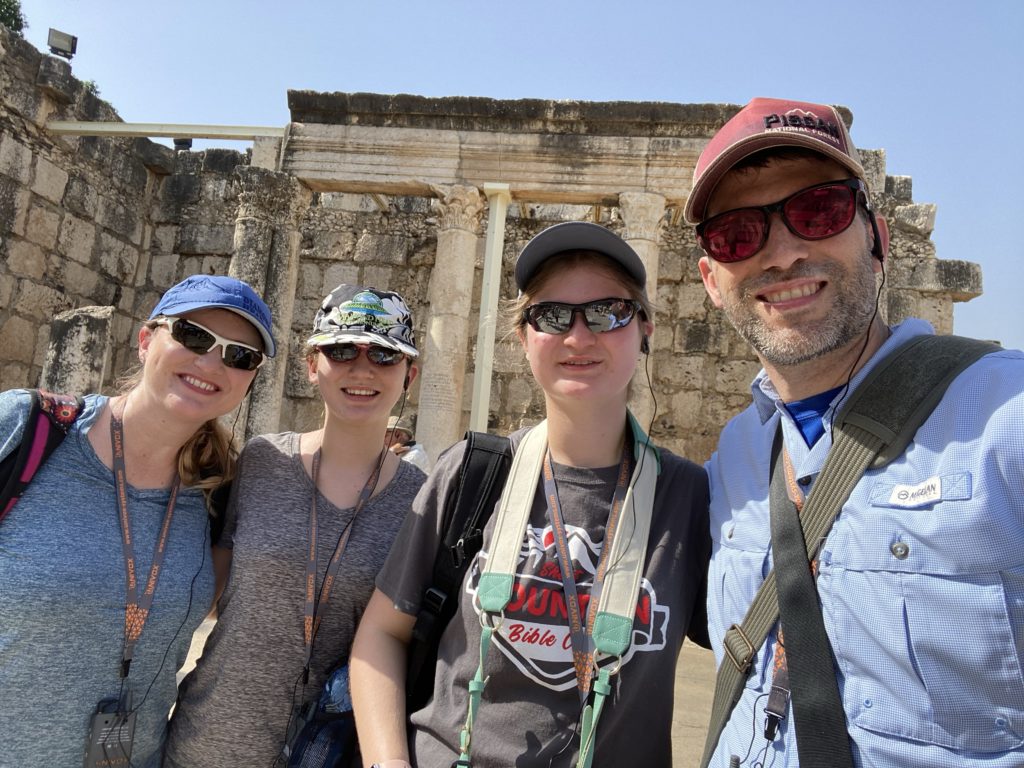
This is very meaningful to me, and very humbling to be standing on the same place where we know this lesson was given.
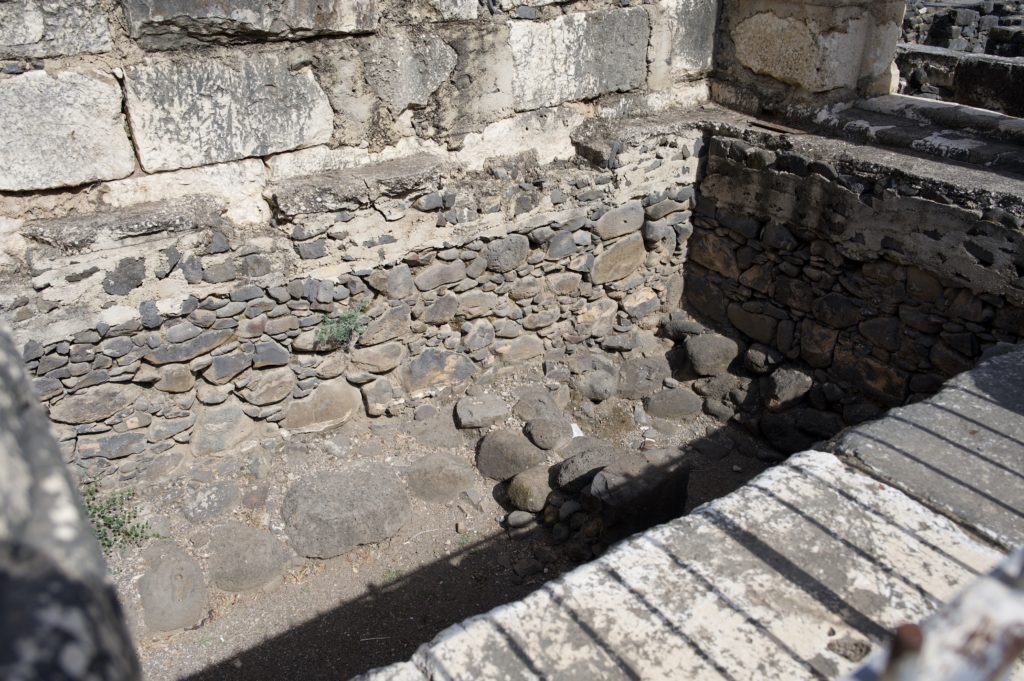
Today you can clearly see the darker stones under the 4th century synagogue which were from the 1st century synagogue. Both Olivia and Kate said that visiting the synagogue was their favorite thing from today, and I think it would be mine as well.
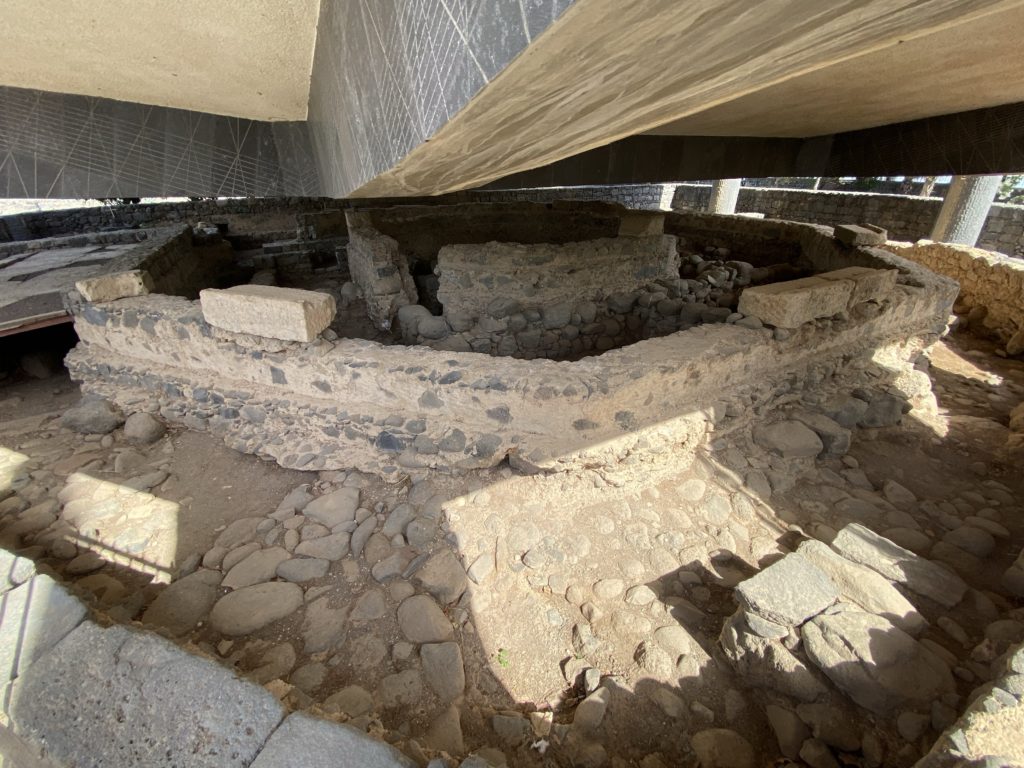
Our final stop was St. Peter’s Church. This is a modern Catholic pilgrimage church that is part of the Franciscan monastery. It is in the shape of an octagon and built on pillars over archaeological excavations. These excavations include a layer of residential structures from the 1st century on which a 5th century octagonal church was built during the Byzantine period. The residential structure is traditionally considered to be Peter’s house from the account of Jesus healing Peter’s mother-in-law in Matthew 8.
Mount of Beatitudes
We left Capernaum and made a short drive to the “Mount of Beatitudes” on the northwestern shore of Galilee between Capernaum and Magdala. This is the traditional location of Jesus’ Sermon on the Mount from Matthew 5-7. The traditional spot was identified by the Byzantines approximately ~350 years after the event.

The site is a natural amphitheater, and the geography generally matches the account in the gospels. However, we have no idea whether this is the actual spot of this great sermon.

On top of the mountain is the Church of the Beatitudes which was built between 1936 and 1938 near the site of the fourth-century Byzantine ruins.
At the site, Ami allowed me to talk about the Beatitudes for a bit before Daniel read them from Matthew 5:1-12. After spending a few minutes walking around the site, we then got back on the bus and decided to try and squeeze in one more site before heading back to the hotel.
Magdala
This site was Magdala, which is on the western shore of the Sea of Galilee, north of Tiberias. The name Magdala means “tower.” This is possibly the birthplace and residence of Mary Magdalene (Mark 15:46-16:1; Luke 8:2-3; John 19:25).
Some manuscripts of Matthew 15:39 refer to Jesus coming into “the region of Magdala,” however this translation is called into question. With that it is unknown if scripture directly supports that Jesus was ever in Magdala. However, it is clearly in the vicinity of much of His ministry, so it is certainly possible that he came here.
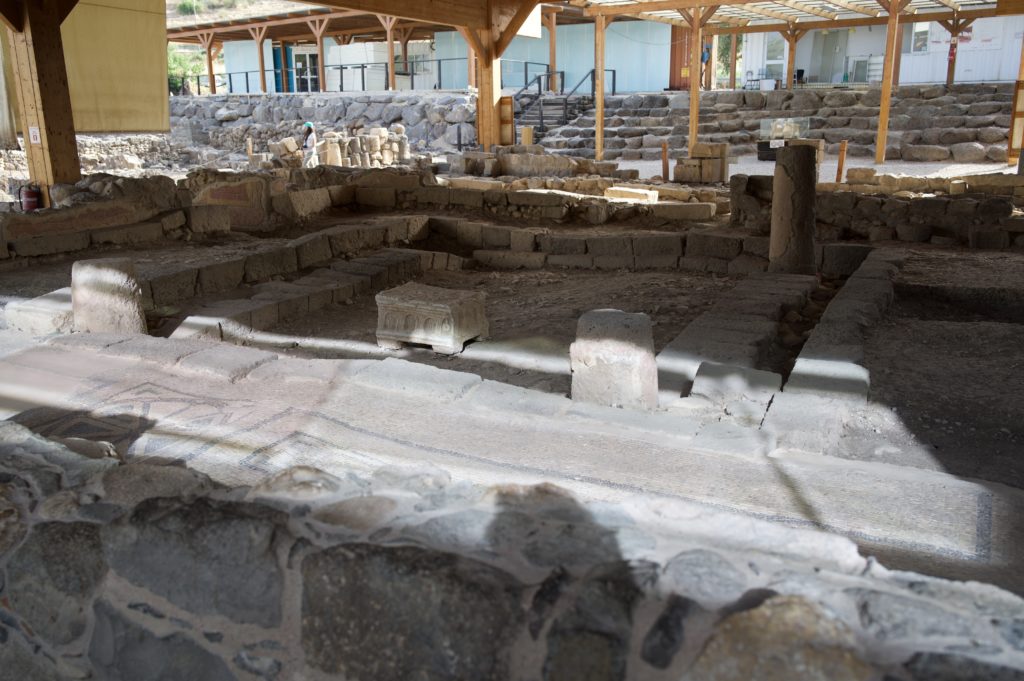
In Magdala, Ami took us to a large 1st century AD synagogue that has been excavated, and parts of its original mosaic floor are still intact. In the middle of the synagogue was found a stone box with four feet that contains imagery from the temple and was likely used for the scroll of the Torah.

From there, we went to the excavation of a public bath area with a couple of Mikvah from the 1st century AD, similar to what we saw in Zippori earlier today. Ami then took us around to excavations of dwelling places and told us that based on the archaeology it appears that Magdala was a much larger city than Capernaum.

While the rest of the group was exploring the Franciscan church that has been built on the site, I went to look at the excavations of port to the Sea of Galilee for Magdala. There was a mosaic of a ship found at this location (removed from site), and the ship looked very similar to the ancient Galilee boat that has recently been found. When I was here two years ago, it was hard to see the lake from this spot because the water was so low. Today it was less than 100 yards from the port, which was neat to see.

I then joined the rest of our group in the church building and visited a new chapel that has been built in the basement of the structure. The floor of this chapel was made of stones from the archaeological site and at the far end is a painting depicting the woman reaching out to touch the garment of Jesus and be healed (Mark 5:21-43). This has all been constructed since the last time I was here.
Back to the Hotel
After leaving Magdala, it was just after 6pm, and we were all completely exhausted. It was over 100º this afternoon, most of which with no breeze. That is by far the biggest difference I’ve noticed from my last trip, which was in January. Today was brutally hot, and I drank a ton of water.

It was good to get back to the hotel, take a shower, and then eat a leisurely dinner with our family. After dinner we went down to the promenade by the Sea of Galilee, and Olivia and Kate ended up playing with cats for most of our time down there.
As this day ends, it’s hard to believe how much we saw. This was by far the most things I’ve seen in one day in Israel. Tomorrow we are supposed to start in Nazareth before heading up to the Galilean Peninsula for Tel Dan and Caesarea Philippi.
